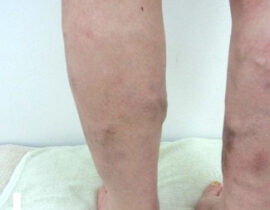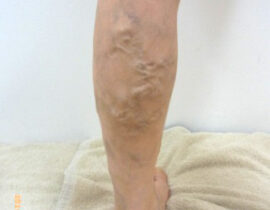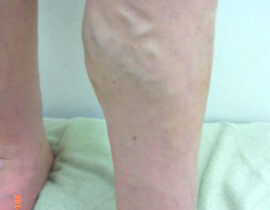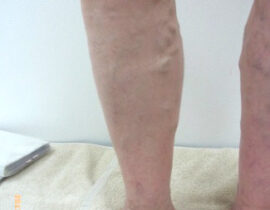Type of varicose veins
1. Greater saphenous varicose veins

Lower extremities veins consist of deep veins and superficial veins and most of the blood flow in legs goes back to the heart through deep veins. Varicose vein is formed in superficial veins that cover about 10% of the blood flow in legs. Among the superficial veins in legs, the one that forms varicose veins most frequently is greater saphenous veins. Greater saphenous vein is the superficial vein that goes up from inside of ankle and is connected to femoral vein at the inguinal region. Varicose vein which is formed on the main duct and the main branches of the greater saphenous vein is greater saphenous varicose veins. The area of outset of varicose vein is lower legs, inside of thigh, outside of lower extremities and the back of thigh.
2. Lesser saphenous varicose veins

Lesser saphenous varicose vein is often seen next to greater saphenous varicose vein. Lesser saphenous vein runs up from the outside of Achilles tendon and is connected to deep vein at the back of the knees. The area of outset of lesser saphenous varicose vein is at the back of ankle or knees.
3. Branch type varicose vein

It is enlarged segmental vein that is ramified from the main saphenous vein. Mainly it is seen below knees and sometimes solitary. Its feature is slightly narrower than saphenous varicose vein.
4. Genital area varicose vein
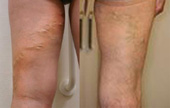
It is varicose vein that occurs due to the blood that backflows from the vein around ovary and womb. Accordingly, the condition worsens when the flow of the blood into ovary and womb increases during menstrual period. When bumpy blood vessel meanders diagonally from the groin at the back of femur and spreads through lower extremity, genital area varicose vein is suspected.
5. Reticular type and Web type (spider veins) varicose vein
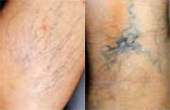
Reticular type varicose vein is the swollen fine subcutaneous veins in the size of 2-3mm in diameter that spread like a mesh. Web type varicose vein is dilated capillary veins that are finer than reticular type in the size of less than 1mm in diameter that exist just below the skin. Web type varicose veins are not bumpy like saphenous varicose veins.
Confusing conditions that is misunderstood zs varicose veins
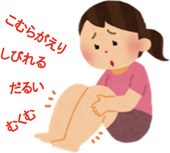
Typical conditions of varicose vein such as leg fatigue, swell, cramp, numbness and pain, are sometimes caused by different diseases.
| Lumbar disk herniation |
|---|
| Intervertebral disk sticks out from the original place and stimulates nerves, which causes numbness and pains in legs. It is rare that both legs have the same conditions at the same time and usually one leg have the condition. |
| Arteriosclerosis |
|---|
| Leg artery becomes narrower or closed due to arteriosclerosis which will become the cause of numbness, coldness, cramp or pain in legs because circulation of blood at distal organization worsens. |
| Lymphangitis |
|---|
| Deterioration of the lymph flow causes swell, heat and pain in lower legs which are similar conditions as varicose vein. |
| Erythema nodosum |
|---|
| Painful erythema sometimes emerges frequently, with the oppressive pain and sense of fatigue, on lower extremities without any direct cause. |
| Chronic eczema |
|---|
| Eruption appears on skin and skin becomes thick or its color becomes dirty brown. Many times it is accompanied by itchiness. |
| Chronic pigmentary purpur |
|---|
| It is relatively rare, but chronic pigmentary purpura has a peculiarity of having itchiness, pigmentation, inflammation, etc. on lower extremities easily. |
| Livedo reticularis |
|---|
| It does not swell, but mesh shaped spot appears on lower extremities with possible pain and ulcer. |
| Hernia of deep fascia of leg |
|---|
| Because the inside of weakened fascia of leg (deep fascia of leg) juts out like a knob, the appearance is similar with the varicose vein. |
| Skin ulcer |
|---|
| This condition is seen on the people who have to keep standing at work, and due to the vascular insufficiency, which is called chronic venous insufficiency described below, sclerema or pigmentation occurs without varicose vein and induce ulcer when the condition worsens. |
| Chronic venous insufficiency |
|---|
| This is induced by the blood congestion in lower extremities which is caused by the chronic disorder of vein currency due to the weakened muscle in lower legs, and has various conditions such as swell, edema, pain, lumpiness, eczema and pigmentation. Remained stricture as a sequel of deep vein thrombosis, and the backward blood flow in the newly created vessel as a bypass are the causes of this disease. |
| Deep vein thrombosis |
|---|
| This is the condition that gathers attention as an economy class syndrome. It could become the cause of pulmonary or brain infarction. Vein thrombosis could occur on any deep veins in the whole body but it can be said that it happens more on lower leg, thigh and in pelvis. |
| Congenital varicose vein |
|---|
| Outset of varicose vein is mostly after becoming adult, but some people have congenital varicose vein with noticeable birthmark or superficial vein from childhood. It is very difficult to cure congenial varicose vein because backflow pressure is normally very high and blood vessels rupture intricately. However, it is not necessarily inheritable. |

